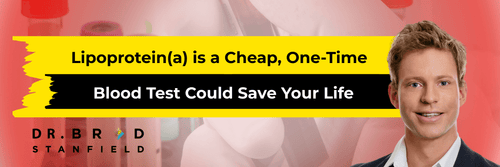It’s GLP-1 medications. I'm not going to keep you guessing. The FDA recently approved these medications for the treatment of fatty liver. But which GLP-1 medication is best? How do you minimize side effects? And no medication is ever a replacement for a great diet, so what’s the optimal diet to reverse fatty liver?
Table of Contents
- Overview of fatty liver disease
- GLP-1s and fatty liver disease
-
Treatment for fatty liver disease
- Reference List
Overview of fatty liver disease
We should start by noting that fatty liver disease is a bigger problem than most realize. According to a recent report, about 38% of people in the U.S. have fatty liver disease that isn’t linked to alcohol. And this number has shot up by 50% in the past 3 decades [1].

That’s a problem because fatty liver is associated with type 2 diabetes, liver cancer, and early death.
But there’s good news. If treated early enough, fatty liver disease and the damage it causes is reversible. The liver has a wonderful regenerative capacity if given the chance. And we’ll say more about how to give it that chance in a moment.
GLP-1s and fatty liver disease
Because fatty liver disease is so closely linked to problems like obesity and type 2 diabetes, a key priority in managing the disease is reaching healthier targets with weight and blood sugar control. And this has raised interest in GLP-1 medications, which have emerged as powerful treatments in both areas.

An early study exploring the potential of GLP-1s to treat fatty liver disease was published in 2016. Researchers looked at the impact of liraglutide on patients with fatty liver disease during a 48-week treatment. Thirty-nine percent of the patients receiving liraglutide saw their fatty liver disease resolve. This compared to just 9% in the placebo group [2].
Liraglutide also prevented further damage. Only 9% of those receiving the medication had worse scarring of the liver, compared to 36% in the placebo group [2].
The results from this early study were strongly encouraging. But the sample size was quite small.
Now I want to clarify something important here for interpreting the results of this study and the others we’ll look at. You can think of fatty liver disease as having two aspects. On the one hand, there is the disease itself — fat accumulating in the liver that damages cells and causes inflammation. On the other hand, there is the longer-term damage: scar tissue, or fibrosis, that forms as the body tries to repair the damage. We want to reverse the disease before scarring occurs, which is why the studies emphasize resolution without worsening of fibrosis.
A larger trial in 2024 included 190 participants with fatty liver disease. It used the GLP-1 tirzepatide at 3 different doses to zero in on optimal dosing. As with the earlier study, they were looking for resolution of the disease without progression of fibrosis [3].

In the treatment groups, substantial shares saw the disease resolved without more scarring. The percentages were 44%, 56%, and an incredible 62%, corresponding to doses of 5, 10, and 15 mg of tirzepatide [3].
Then, just this spring, researchers reported the first batch of results from an ongoing phase 3 trial. This one is testing semaglutide (or Wegovy) in over eleven hundred patients for nearly 5 years. The researchers planned an initial look at how things were going after 72 weeks. It’s those results that were just published [4].
So far, so good. Fatty liver disease was resolved without more scarring in 62.9% of the treatment group compared to 34.3% in the placebo group [4].
What’s more, 32.7% in the semaglutide group had both resolution of the disease and a reduction in fibrosis. The medication both put out that fire and helped repair the burn damage. That compared to 16.1% in the placebo group [4].
It was on the strength of these findings that the FDA in August approved semaglutide to treat non-alcoholic fatty liver disease [5].
As the FDA noted in their release: “Wegovy’s efficacy was demonstrated in one ongoing phase 3 trial.” [5]
This is a really big deal. It puts a new tool in our arsenal to fight a serious health problem. And there’s reason to expect even more effective therapies will be approved soon. That’s because newer GLP-1 meds like tirzepatide are even more effective than semaglutide when it comes to losing weight. Tirzepatide targets two distinct pathways instead of semaglutide’s one. As a result, it empowers even greater weight loss.
In one head-to-head study, patients taking tirzepatide experienced about a 7% greater weight loss after one year than those taking semaglutide [6].
And even though weight loss isn’t the only reason GLP-1 meds help treat fatty liver disease, it’s one of the most important.
Treatment for fatty liver disease
But medications like semaglutide are just part of the picture. They aren’t a replacement for a healthy diet. And we need to talk about diet for a moment because there’s a key problem with GLP-1 medications we want to avoid.

This problem is this: when we lose weight, fat isn’t the only thing that goes. We’re losing weight because we are eating fewer calories than we need. In response, our bodies draw on the energy stored as fat. But they can also recycle muscle tissue to get the materials they need. So we end up losing muscle along with the fat.
This is a well-known issue and is expected to some extent with weight loss. One study, for instance, looked at lean tissue loss with a calorie-restricted diet with or without exercise. After about 4 months, participants had lost around 7% of their body weight. For the non-exercisers, about 2% of the loss was in lean tissue. Though lean mass isn’t just muscle, it includes it [7].
Something different happened in the exercise group, which we’ll come back to in just a moment.
Again, loss of lean mass is expected with weight loss. But with GLP-1 meds, the losses can be especially high. This is because the weight loss is both large and rapid. A systematic review of trials with semaglutide found lean mass loss as high as 40% in some cases [8].
So now here’s how diet enters the picture. We want to ensure we’re getting adequate protein, which helps preserve muscle mass. The RDA for protein for adults is .8 g/kg/day. I advise my patients to boost that to 1.2 g/kg of ideal body weight a day.
And I also encourage them to focus on plant-based proteins. This is because sources like lentils, chickpeas, and beans are packed with fibre, which helps amplify weight loss. It increases feelings of satiety after a meal so we naturally eat fewer calories.
There’s an important caveat here, however. People with irritable bowel or other inflammatory bowel conditions need to be careful. Too much fibre can aggravate these conditions.
But protein by itself is only part of the equation. When it comes to preserving muscle mass, exercise is critical. It signals to our muscles that they need to be building, not cutting back. The evidence suggests resistance exercise is particularly powerful [9].
Returning to the study I mentioned a moment ago, the group that exercised along with calorie restriction lost half as much lean mass as the non-exercise group [7].
So for my patients, when we start on GLP-1 meds we pay extremely close attention to exercise. Maximise fat loss, and minimize muscle loss.
Exercise also boosts weight loss and improves insulin sensitivity. Both of these are vital in combatting fatty liver disease.
In addition to a good diet and getting more active, there are four additional things that are important for managing fatty liver disease.
1. Avoid alcohol. Heavy alcohol use has been linked to disease progression in studies. While the evidence for moderate alcohol consumption is less clear, it makes good sense to err on the side of caution here.
2. Address heart disease risk factors. Fatty liver is an independent risk factor for the buildup of plaque in the arteries and the heart attacks and strokes that can result [10]. So I tend to be more aggressive with lowering my patients’ LDL-c and ApoB in the clinic if they have fatty liver disease.
3. Add black coffee. That might sound like surprising advice. But a systematic review found black coffee consumption was inversely related to the severity of scarring in individuals with fatty liver disease [11]. So long as we’re not adding sugar or cream to the coffee.
4. Ensure adequate vitamin D. Research has uncovered an association between vitamin D deficiency and the risk of fatty liver disease. There’s also a link with the severity of the disease [12].
Besides, there are plenty of other health links that make getting enough vitamin D a priority. To make sure I get enough, I include 1,000 IU in MicroVitamin. But just because I take a supplement, that in no way means you also need to.
Now I want to add one final note about GLP-1s for the treatment of fatty liver disease. Something many don’t realize is that they are long-term medications. That’s because when people go off them, the weight they lost tends to return quickly. This dynamic is clearly seen in a study of semaglutide [13].

And that’s why I usually recommend that my patients try lifestyle changes first to address weight.
Reference List
1. https://diabetesjournals.org/spectrum/article/37/1/9/153831
2. https://pubmed.ncbi.nlm.nih.gov/26608256
3. https://pubmed.ncbi.nlm.nih.gov/38856224
4. https://www.nejm.org/doi/full/10.1056/NEJMoa2413258
6. https://jamanetwork.com/journals/jamainternalmedicine/fullarticle/2821080
7. https://pmc.ncbi.nlm.nih.gov/articles/PMC5161655
8. https://pubmed.ncbi.nlm.nih.gov/38629387
9. https://www.sciencedirect.com/science/article/pii/S2161831322006810
10. https://www.ahajournals.org/doi/10.1161/ATV.0000000000000153
11. https://pmc.ncbi.nlm.nih.gov/articles/PMC8308484
12. https://pmc.ncbi.nlm.nih.gov/articles/PMC10015758
13. https://dom-pubs.pericles-prod.literatumonline.com/doi/10.1111/dom.14725







































